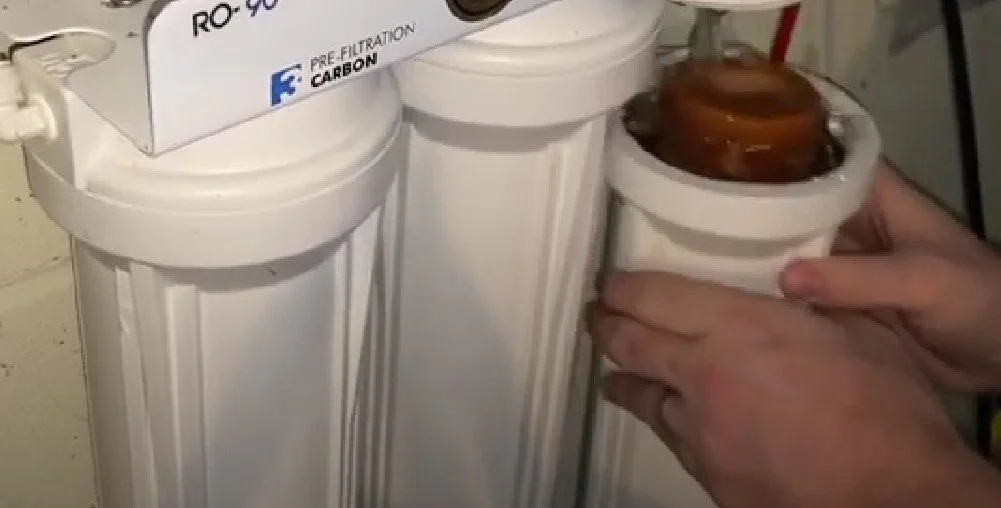If you own a reverse osmosis (RO) water filtration system, regular filter replacement is essential to ensure it functions efficiently and continues providing clean, safe drinking water.
In this guide, we'll walk you through the step-by-step process of replacing your RO filters, making it easy to maintain your system and extend its lifespan.
Whether you're a seasoned DIYer or a beginner, this comprehensive guide will help you get the job done with confidence.
Here are the steps to follow to perform a reverse osmosis filter replacement, as well as some other frequently asked reverse osmosis filter replacement questions.
Step 2: Shut off Water Supply
Step 3: Remove the Old Cylinders
Step 4: Remove the Old Filter
Step 5: Clean the Empty Cylinders
Step 6: Install the New Filters
Step 7: Turn the Water Back On
Step 8: Run Your Faucet
2. How Often Should You Do a Reverse Osmosis Filter Replacement?
3. How Much Do Replacement Filters Cost?
If you would like to install a reverse osmosis system in your home, contact us.
1. Reverse Osmosis Filter Replacement Steps
Step 1: Purchase the correct replacement filter
Before you start your reverse osmosis filter replacement, purchase the correct new filters
Before your start your reverse osmosis filter replacement, make sure you have the correct filters.
You can take a picture of your unit showing the make and type of your reverse osmosis system, or if you have an old filter, you can take that with you to your water filtration store to make sure that you purchase the right type.
Step 2: Shut off Your water supply
Make sure you shut off the water supply at the waterline and the R/O tank.
Image source: Everyday fixes and DIYs: How do I do that?
You need to turn off the water supply at two different spots. Find where your water enters your R/O system.
Turn the valve clockwise on the feed waterline (the line that connects to your system from your home’s main water supply line) for your system until it is off.
Depending on the type of valve, you will need to turn it clockwise until it is closed or turn it 90 degrees to the connecting tubing.
This will shut off your water supply to the system. Then, turn off the valve on your tank by turning it 90 degrees to the tubing.
Step 3: Remove the Old Cylinders
Turn the bottom of each cylinder to the left to loosen it. Some systems will come with a special wrench-like tube that helps you loosen the cylinders. Then continue turning the cylinders until they come off of your reverse osmosis unit.
Carefully remove each cylinder in turn.
Image source: Everyday fixes and DIYs: How do I do that?
Note: The cylinders will be full of water, so it is a good idea to place a bucket under the cylinders to catch any water that spills out and to dump the remaining water into.
Step 4: Remove the Old Filter
You can simply lift out the old filter from inside of the cylinder. Continue this process for all the cylinders in your reverse osmosis system.
Step 5: Clean the Empty Cylinders
Rinse out each of the cylinders with clean water making sure you remove any remaining sediment.
Step 6: Install the New Filters
Place the correct filters into each canister
Image source: Everyday fixes and DIYs: How do I do that?
Remove the outer wrapping on the new filter. Place the correct filters into each canister and replace them back on the system screwing them on so that they are secure. It's usually easier to replace them in the reverse order of how you removed them.
Step 7: Turn the Water Back On
Turn the water back on to your tank and from your water feed line
Image source: Everyday fixes and DIYs: How do I do that?
Turn the valve to the tank back on and turn the water back on. You should hear the water starting to fill up your reverse osmosis system again.
Step 8: Run Your Faucet
Turn on your water faucet in your sink and let it run for a few minutes to drain out the water from the tank and start flowing through the new filters.
2. How Often Should You Do a Reverse Osmosis Filter Replacement?
It's a good idea to do a reverse osmosis filter replacement once a year. You could set up a Google Calendar reminder to let you know when it is time to make the change.
3. How Much Do Replacement Filters Cost?
The price of your replacement filter will depend on the type of system you have. On average, it could cost you anywhere from $60 to $200 per year for filters.
4. How Much Do Reverse Osmosis Systems Cost?
On average, reverse osmosis systems can cost anywhere from $300 for a small portable system to $5,000 and up for a higher quality, whole-house system.
5. How Does Reverse Osmosis Work?
The following video will give you a general visual explanation of how a reverse osmosis system works. Read on to find out more about how it works.
Learn more about the reverse osmosis process
1. Pre-filtering Stage
During the initial filtration stage, your tap water or well water (pressurized by a booster pump) passes through a particle filter (a pre-filter) that removes silt, sediment, sand, and clay particles that might clog the membrane of your reverse osmosis unit.
2. Carbon Filter Stage
Next, the water is forced through an activated carbon filter that traps minerals and contaminants such as chromium, mercury, copper, chloramine and pesticides.
It also removes chlorine, which is important, as chlorine will make your membrane deteriorate faster.
3. The Reverse Osmosis Module
Only clean water can pass through the tiny pores in the membrane
Water is then transferred under pressure into the reverse osmosis module. Only clean water is able to pass through the small pores in the membrane. Impurities are blocked by the membrane and are then flushed down the drain.
4. Second Carbon Filter
If your reverse osmosis system is equipped with a second carbon filter, then your treated water is sent to a storage tank where it passes through a second activated carbon filter to further improve the water's taste and smell.
The Duro Reverse Osmosis System, available at WaterSmart, features a two-step filtration process known as pre and post-carbon block filtration.
The carbon filters act as a complementary measure to block dangerous chemicals like pesticides, herbicides and chlorine, which are small enough to pass through the reverse osmosis filter.
Trust WaterSmart for All Your Home Water Needs
WaterSmart has been serving the Waterloo region since 1994. We can help you select the best water treatment system including reverse osmosis systems for your particular needs. We’ll happily answer all of your questions and offer you a system that will fit your budget and requirements.
We are committed to helping you improve the quality of your home's water. We live and work in the Kitchener-Waterloo region so we understand the hard water challenges of this area.
Contact WaterSmart today to book an appointment.
“What a great experience!! I did a search on the internet, called regarding the price of a water softener and the next day it was installed and we had soft water again. Paul removed the old softener, installed and setup the new one and was out in just over an hour. He also noted that the grounding of water pipe was not done by previous installer and he corrected that as well. Cost was the same as softener that was installed 14 years ago - I am impressed.”











